Floral Motifs on Early Chintz
Rubus sp. - Raspberries and Blackberries
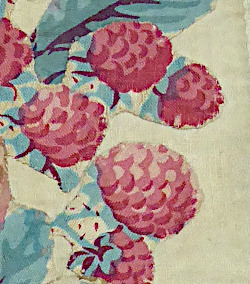
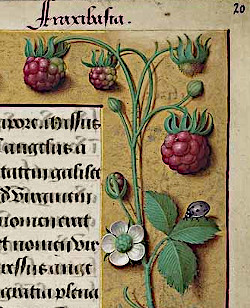
%20-CC0--%20via%20Wikimedia%20Commons_web.jpg)
Rubus sp. (Raspberries and Blackberries) from the Edisto Island Museum, Edisto Album Chintz Applique Spread, dated 1863. Photo courtesy of Edisto Island Museum.
Rubus sp. (Raspberries) from J. Bourdichon, Grandes Heures Anne de Bretagne, 1503-1508
Rubus sp. (Raspberries) by AnRo0002 (Own work) [CC0], via Wikimedia Commons
Common Names: Brambles (both raspberries and blackberries in the U.S., blackberries only in Britain), Caneberries (both raspberries and blackberries in the U.S.), Common Brambles, Red Raspberries, European Red Raspberries, American Red Raspberries, Virginian Raspberries, Black Raspberries, Blackberries
Description: Rubus sp. (Raspberries and Blackberries) are members of the Rose Family (Rosaceae). The Hortus Kewensis, ed. 2, vol. 3 recorded fourteen species of Raspberries and Blackberries native to Britain, Scotland, Labrador, the Cape of Good Hope and St. Helena, North America, and Canada. On chintz the illustrations of members of the genus Rhubus are difficult to distinguish due to extensive hybridization and plant selection as well as artistic license. The difference between raspberries and blackberries in the garden or in the wild is simpler. When the fruit of raspberries is picked it comes loose from the stem and the berry itself is hollow, as opposed to blackberries where the stem is usually retained when picked and must be removed. In today's gardens blackberry fruits are generally much larger that raspberries. Both blackberries and raspberries grow on upright or arching, generally thorny, canes hence the name brambles. Raspberries tend to be small rounded berries while blackberries tend to be larger, taller berries. Dewberries, another species of Rubus, are ground-hugging small vines and are thus very unlikely to be illustrated on chintz, but their berries are generally indistinguishable from blackberries.
Quilts with the Rubus sp. (Raspberries) motif illustrated above:
Chintz with the Rubus sp. (Raspberries) motif illustrated above:
Description: Rubus sp. (Raspberries and Blackberries) are members of the Rose Family (Rosaceae). The Hortus Kewensis, ed. 2, vol. 3 recorded fourteen species of Raspberries and Blackberries native to Britain, Scotland, Labrador, the Cape of Good Hope and St. Helena, North America, and Canada. On chintz the illustrations of members of the genus Rhubus are difficult to distinguish due to extensive hybridization and plant selection as well as artistic license. The difference between raspberries and blackberries in the garden or in the wild is simpler. When the fruit of raspberries is picked it comes loose from the stem and the berry itself is hollow, as opposed to blackberries where the stem is usually retained when picked and must be removed. In today's gardens blackberry fruits are generally much larger that raspberries. Both blackberries and raspberries grow on upright or arching, generally thorny, canes hence the name brambles. Raspberries tend to be small rounded berries while blackberries tend to be larger, taller berries. Dewberries, another species of Rubus, are ground-hugging small vines and are thus very unlikely to be illustrated on chintz, but their berries are generally indistinguishable from blackberries.
Quilts with the Rubus sp. (Raspberries) motif illustrated above:
- The Edisto Island Museum, Edisto Album Chintz Applique Spread, "Lowcountry Chintz: The Townsend/Pope Quilt Legacy", Uncoverings 2013, dated 1863
- Colonial Williamsburg, The James Betts quilt, Colonial Williamsburg Online Collections (http://emuseum.history.org) and search for James Betts quilt, c. 1840
Chintz with the Rubus sp. (Raspberries) motif illustrated above:
- None known at this time
Additional Rubus sp. (Raspberries and Blackberries) Motifs
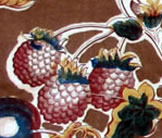
Rubus sp. (Raspberries or Blackberries) from the Henry Francis du Pont Winterthur Museum, Furniture Fabric Fragments, c.1830. Courtesy, Winterthur Museum, DETAIL-Printed textile, c.1830, England, Cotton, Bequest of Henry Francis du Pont, 1969.3128.1
Chintz with this Rubus sp. (Raspberries or Blackberries) motif:
- The Henry Francis du Pont Winterthur Museum, Furniture Fabric Fragments, Object Numbers 1969.3128.001, 1969.3128.002, 1969.3929.001, 1969.3929.002, 1969.3929.003, c.1830
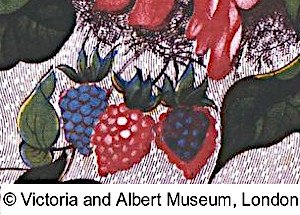
Rubus sp. (Probably Blackberries) from the Victoria & Albert Museum, Furnishing Fabric Made in Lancashire, made 1830
Chintz with this Rubus sp. (Probably Blackberries) motif:
- Victoria & Albert Museum, Furnishing Fabric Made in Lancashire, Object Number Circ.286-1956, made 1830
- Henry Francis du Pont Winterthur Museum, Printed Textile Created by John Potts, Object Number 1959.0084.055, Printed Textiles: British and American Cottons and Linens, 1700-1850, p. 301, 1825-1835
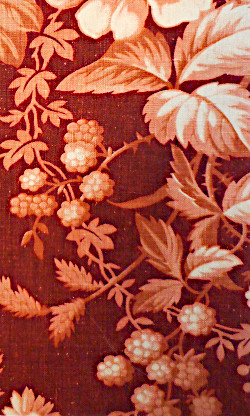
Rubus sp. (Raspberries) from the Private Collection, French Floral Rust and Tan Fabric Fragment with Foxgloves and Raspberries, c. 1840
Chintz with this Rubus sp. (Raspberries) motif:
- Private Collection, French Floral Rust and Tan Fabric Fragment with Foxgloves and Raspberries, c. 1840
© Updated 6/7/2020 Author: Terry Terrell